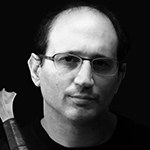By Eyal Azerad

During the early Middle Ages, the primary metal available for the manufacture of swords was derived from bloomery iron, made by heating iron ore with charcoal in small furnaces. While sufficient for some applications, the finished iron was plagued with slag inclusions that weakened the metal, rendering a sword blade that was prone to break when struck with force against a hard object, such as a shield or another sword.
Quantitative analysis of early Viking swords revealed that the carbon content of the blades was very low when compared to later steels. Three pattern welded blades from Norway were analyzed: their carbon content ranged from 0.401 percent carbon, to 0.520 percent carbon. This is the typical carbon content of swords of the period from all over Europe and Scandinavia.
When considering the low carbon content of the steel, combined with the typical amount of slag inclusions in early medieval steel, the result was an excessively soft blade prone to breakage and damage at a time when his life depended on the quality of his sword.
One sword stood out among all others during the time, however: a Viking Sword that is known as the Ulfberht. While medieval steel was weak, containing particles of slag, the steel of the Ulfberht swords was different : Ulfberht – a superior steel that could not be replicated until well into the 1880s during the Industrial Revolution.
The Ulfberht swords were made of crucible steel, which was not at all common during the Middle Ages. Being cast in a crucible, this type of steel burned much hotter than contemporary steels, thus burning off most, if not all, of the slag so common to steels of the day.
In addition to this difference in smelting, swords made of this type of steel contained far more carbon – while most steels contained a carbon content of as high as 0.520, the steel of an Ulfberht sword contained as much as between 1.2 percent and 1.6 percent. In modern classifications, steel of this carbon content is categorized as spring steel. Thus, the Ulfberht sword was far stronger – and far more flexible – than standard medieval steel. It possessed the ability to bend when thrust at a hard object such as a shield, whereas other swords risked cracking, breaking, or shattering under such duress.
Ulfberht swords were extremely rare and undoubtedly far more expensive than other swords manufactured at the time. Of the thousands of Viking swords that have been recovered throughout Scandinavia and Europe, only 171 are marked as Ulfberhts. Of these, less than 50 have proven to be genuine Ulfberht swords.
One of the distinguishing characteristics of an Ulfberht sword was that name was inlaid in the blade using a contrasting steel. The first letter and the last letter of the name were preceded by a cross, rendering the appearance of the inscription as +Ulfberh+T. Others that have been recovered bear the inscription +Ulfberht+.
Metallurgical analysis of swords bearing both inscriptions has revealed that the +Ulfberh+t swords contained a far superior carbon content, making them the equivalent of modern-day spring steel, while the +Ulfberht+ swords were of common medieval steel.
This suggests that the +Ulfberht+ swords were cheap copies designed to appear as the genuine article.
Metallurgical analysis has also revealed that the Ulfberht swords were only made between 800 and 1,000 CE, offering a clue as to where such high quality steel originated. Archaeological excavations have suggested that the Vikings did not manufacture their own steel.
However, other archaeological digs have established that the region of eastern Iran was, in fact, manufacturing crucible steel in furnaces far superior to any found in Europe before the 19th century. Many clues suggest that the Vikings obtained the steel via the Volga Trade Route, which they utilized from approximately 800 until the trail was closed to navigation in 1,000, which is the same year that manufacture of the Ulfberht swords stopped.
About the author:
 Eyal Azerad is the founder of Darksword Armory. His lifelong dedication to the study of Medieval and Renaissance sword-making led to the creation of the business in 1996. Since, Eyal Azerad and Darksword have been involved in various movie and stage productions and was invited to give various educational conferences.
Eyal Azerad is the founder of Darksword Armory. His lifelong dedication to the study of Medieval and Renaissance sword-making led to the creation of the business in 1996. Since, Eyal Azerad and Darksword have been involved in various movie and stage productions and was invited to give various educational conferences.



Greetings again! I am a return customer. I await the day you put a modern (and hopefully affordable) Ulfbehrt variant up for purchase. I am also still hoping to see a European “sword breaker” short blade sword in a true “battle ready” quality produced and placed up for purchase. I know that I have asked about the sword-breaker before, please don’t take offense that I ask again. If you have the time, please drop me a reply with an update if and when I can expect to see these. Thank you in advance. DSM
i have a couple questions about the ulfberht sword… what time period were they used in… also would king, phesants, vikings or anyone else use them…… were they fighting sword or design swords for good loooks… thank you for helping me please get back to me soon.
carla
Pheasants never used Ulfberts…the handles are too big for their wings
Carla, riposte! re-post! Seriously though, You could look quite generous while placing a knock off Ulfbert in a Vikings grave, but pity the karl in Valhalla when he finds it to be a copy. My question is why is a sword made for the Norse market not lettered in Futhark? Most vikings could probably not see the difference in +UlfbEr+t and +UlfbErt+ methinks.
Translated from Danish, “Ulf” means “wolf”, and “Ber” means “pray”.
So maybe Ulfberht is just some battle name for praying wolf…?